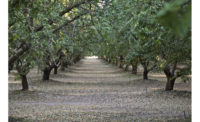The Almond Board of California featured its four goals for 2025 during ISM, including:
1. Further reducing the water used to grow almonds
Over the past two decades, almond farmers have successfully reduced the amount of water needed to grow a pound of almonds by 33 percent via improved production practices and adoption of efficient micro-irrigation technology. By 2025, the California almond community commits to reduce the amount of water used to grow a pound of almonds by an additional 20 percent.
2. Increase adoption of environmentally friendly pest management tools
Responsible almond farming requires protecting the crop and trees from bugs, weeds and disease through an integrated pest management approach. This means using tools and techniques like beneficial insects, habitat removal, mating disruption and, when necessary, pesticides. To further protect our orchards, employees and communities, by 2025, we commit to increase adoption of environmentally friendly pest management tools by 25 percent.
3. Achieving zero waste in its orchards
Almonds grow in a shell, protected by a hull, on a tree: products traditionally used for livestock bedding, dairy feed and electricity generation. Changing markets for these coproducts are spurring innovation for higher value uses, both economically and environmentally, with promising leads in the areas of recycled plastics, fuel, beer and more. By 2025, the California almond community commits to achieve zero waste in our orchards by putting everything we grow to optimal use.
4. Improving local air quality during almond harvest
California almonds are harvested by shaking the nuts to the ground where they dry naturally in the sun before being swept up and collected, a process that can create dust in our local communities. To address this nuisance, the almond community is taking short- and long-term steps to reimagine how we harvest and, by 2025, commits to reduce dust during harvest by 50 percent.







